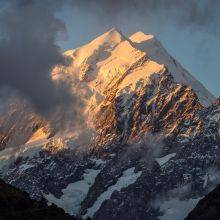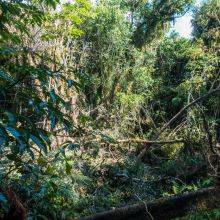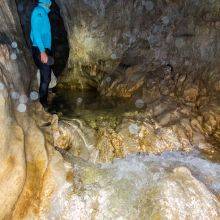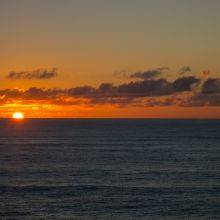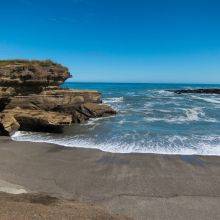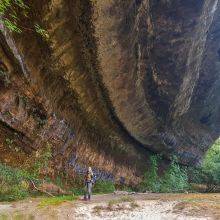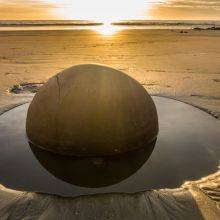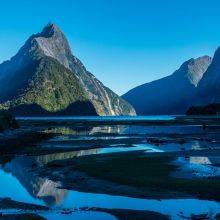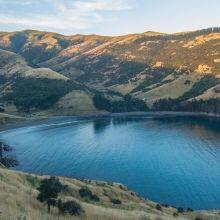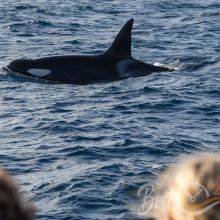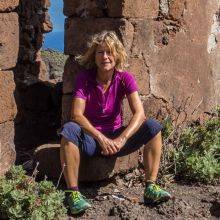When Is the Best Time
Franz Josef is a unique glacier and the only one in the world-leading along a rainforest and ending up in the sea. It is the most accessible glacier ending just 300 m above sea level.
However, climate change is real, and you can witness the vast loss of snow and ice throughout the decades. In former times just ten years ago, you could walk to the glacier's end and 40 years ago on the glacier on your own. None of it is safe any longer, but you know everything is possible in New Zealand.
I like to show you three different opportunities to experience this breathtaking glacier and some amazing hikes on the South Island of New Zealand.
New Zealand, especially the west coast of the South Island, is notorious for its unpredictable weather patterns. It is the wettest area of New Zealand; therefore, visit Franz Josef, not in a rush. I recommend two whole days for Franz Josef to be on the safer side if you wish to do the most thrilling tour of all the “Heli Hike”.
The guides want you to have the best experience ever, which means they check the weather forecast permanently. My nephew did the Heli Hike, and he still calls it the best trip he ever did. His flight was scheduled for 9 am in the morning. It was foggy and a little rainy that day.
The tour company got in contact with him and told him they monitor the weather, and it looks like it improves in a few hours. Isn’t that great? Of course, he was super excited and feared they might cancel the trip. In the end, he got his call and did this bucket list tour with a blue sky.
- Weather Franz Josef Village and Glacier
- How Many Days to Spend at Franz Josef
- Winter (June-August) - Low Season
- Summer (December-March) - Peak Season
- 3 Ways to Experience Franz Josef Glacier
- 3 Additional Hikes at Franz Josef Glacier
- Franz Josef Versus Fox Glacier
- 5 Tips for Your Visit at Franz Josef Glacier
- 8 Facts About Franz Josef Glacier
Weather Franz Josef Village and Glacier
Franz Josef experiences significant rainfall throughout the year, also in the drier season. For visitors from abroad, the weather patterns can be confusing. The weather is influenced mainly by westerly winds transporting moisture-laden air from the Tasman Sea. Therefore, a sunny summer day can end up with snow flurries. Rain is part of all; without it, there wouldn’t be the impressive glacier, the lush rainforest or milky glacial rivers.
The annual precipitation ranges from three metres at sea level to five at the glacier villages, and a whopping 10 m of snowfall on the top of the glacier. The good news is that usually, the sky clears from the southwest before the next cloudburst appears.
When to Visit Franz Josef Glacier
If you are looking for the best time to visit Franz Josef Glacier and the South Island of New Zealand, go in the wintertime, the driest season, from June to August. However, there are more sunlight hours and higher temperatures in the summer. We went to Franz in April and our nephew in March, and with a bit of luck, you get blue spots in the sky.
How Many Days to Spend at Franz Josef?
Most important, don’t come in a rush. All these tours are weather depending. If you spend two full days - three nights in Franz Josef Village, you increase your chance of good weather conditions for the Heli Hike to the pristine snow and a walk to the glacier viewpoint.
Best Daytime for Franz Josef Glacier
The best daytime and quietest time of the day is in summer after 5 pm and in winter after 3 pm when the helicopter flights decrease and finish for the day.
Due to the low elevation, Franz Josef Village experiences a mild climate and winter temperatures range from 5-10°C. Snow and ice occur at high elevations in the mountains and passes only.
Winter (June-August) - Low Season
There are three reasons why I recommend the colder months for a journey to the New Zealand Southern Alps and the south island.
- Less precipitation occurs, and days are more stable. The chance of clear blue skies is the highest.
- Days on the glacier are crisp, cold, and clear. The fresh snow in higher elevations and the clear blue ice are spectacular and can’t look better than in winter.
- It is the quietest and cheapest time of the year because most people prefer the summer, the warmest time as we did. Hotels and hostels are not fully booked.
Summer (December-March) - Peak Season
Summer is the most popular time, and many Europeans escape the cold winter. Days are pleasant, frequently topping 20°C, but as often said, “4 seasons in one day”. The weather is unpredictable and can pour for hours or days. We and also our nephew experienced almost all-weather patterns during our visit. Franz Josef Village is prone to floods, especially in the summer.
These are my recommended tours via GetYourGuide. Thx for booking via my website! With your support, I am able to provide all information first-hand. Tour prices are at no extra cost!
Best Months to Visit
Location and Tips

You like to visit Franz Josef Village and Glacier? Maybe now is the best time because pre-Covid levels are not reached before 2026, with 4 million visitors annually.
3 Ways to Experience Franz Josef Glacier
There was an immense loss of ice in 2012, the reason a helicopter hike is the safest way to explore Franz Josef nowadays. The best thing is you get directly to the blue ice, the caves, and crevasses.
1 Heli Hike
Of course, the most thrilling tour of all is the Heli Hike. You get spectacular views from the helicopter; the next fantastic step you are landing on this snow and ice field. Now comes the highlight you will hike on this stunning glacier with the right equipment you get borrowed by the tour company. These guides know exactly what they do and prepare a narrow path for you through the glacier. You may take some of the best pictures ever with blue turquoise ice on the glacier.
2 Flight Above Franz Josef Glacier and Fox Glacier
Another great tour is the flight above Franz Josef, maybe even above the clouds. You get scenic views to the top of the glacier, but you stay warm inside the heli, and that is not all. You are landing on the glacier to touch the ice and get a fantastic shot of yourselves.
3 Franz Josef Glacier Valley Walk
We live close to the Alps, and we are used to snow and ice, the reason we decided to get closer views of Franz on different trails. We hiked to the bottom of the glacier, the very end of the trail you are allowed to access alone. This hike leads through the glacier bed where Franz covered the ground in former times. It is an uneven rocky path, almost always with views of Franz Josef.
You pass by waterfalls to the right side and beautiful rock formations, depending on the season. It looks so surreal; in front of you is snow and ice, and next to you are fern trees. What a magnificent landscape mother earth created here. Trail closures occur if heavy rainfall is predicted, and floodings could happen. The wide river and glacier bed are too dangerous at these specific times.
- Parking: Franz Josef Glacier Car Park Google Maps
- Trail Length: 6.8 km return
- Duration: 2 hours
3 Additional Hikes at Franz Josef Glacier
Luckily, we spent three nights in the Franz Josef Village, and after the stellar Franz Josef Glacier Valley Walk, we wanted to explore more.
1 Peters Pool – Wheelchair Accessible
It is a leisurely stroll to a lake formed 200 years ago by ice melting. You get a glimpse of Fran Josef from here and the mountain peaks.
- Parking: Franz Josef Glacier Car Park
- Trail Length: 1 km return
- Duration: 25 minutes
2 Callery Waiho Walk
It is an easy wide track through lush rainforest to the Callery River and Gorge Bridge; just the last 15 minutes are narrow, and you may walk through puddles after rainfall.
You can continue on this trail until Robertson Point, but this is a very long day hike of 9 hours – 21.6 km return. It is a well-maintained trail and, best of all, not well known. Most visitors concentrate on Franz Josef and Fox Glacier. We planned to hike this track, but a big rockslide and flooding destroyed the track after the Callery Gorge Bridge.
- Parking and Trailhead: Tatare Tunnels (Google Maps)
- Trail Length: 5 km return
- Duration: 1 ½ hour
3 Roberts Point Track
This is a more challenging and uneven trail offering the best and closest view to Franz Josef Glacier from higher elevations. You first follow the Douglas Walk, which leads above the Douglas Swingbridge and then to the right to Roberts Point. Another hour later, you reach the picnic shelter Hendes Hut convenient on a rainy day. Some parts of the trail are slippery, and hiking boots are essential.
- Parking: Franz Josef Glacier Car Park
- Trail Length: 12.3 km return
- Duration: 5 ½ hours
Franz Josef Versus Fox Glacier
We hiked both trails to the bottom of the Fox and Franz Josef Glacier. We wanted to repeat the outstanding experience at Franz Josef, and we were curious about Fox. Fox is great as well, but if you are limited in the time, I vote for Franz.
There was a vast rockslide roughly five years ago, which changed the entire landscape at Fox Glacier. The trail is much broader and not that close to such breathtaking rainforest. There are plenty of hikes around Franz Josef Village and only a few at Fox. If you have plenty of time, do it; if not, check out Franz Josef only.
5 Tips for Your Visit to Franz Josef Glacier
- Stay at least 2 days 3 nights to increase your chance of good weather conditions. I assume our motel doesn't exist any longer because of Covid 19 lockdowns. However, I highly recommend booking the hotel or guesthoúse in advance due to the limited availability. Franz Josef Village booking.com
- There is a huge parking lot at Franz Josef Glacier. Parking at the trailheads is free.
- The last available restrooms are at the parking lot of the Franz Josef Valley Walk.
- Never travel without rain gear to the south island of New Zealand and especially to the west coast. Regardless of the season and forecast, weather is unpredictable usually all 4 seasons in one day. Also, wear proper shoes for hiking the uneven tracks.
- Do you plan to do the Heli Hike or the Glacier Flight? Book these trips in advance to avoid disappointment because of the limited availability.
8 Facts About Franz Josef Glacier
- Franz Josef and Fox are constantly fast-moving because of their steep lower section. The average speed of a glacier is a maximum of a meter, usually 50 cm per day, but Franz Josef held a record of four meters. These glaciers are “built” for speed, starting at 3000 m elevation and descending to 260 m in just 10 km.
- Tourism in the Westland National Park and at Franz Josef Glacier started late in 1960.
- In the 1980’s the first helicopter accessed the top of the glacier.
- In 1990 the entire Westland National Park became a World Heritage Site
- Franz Josef has been a retreating glacier since 2008 and has lost more than 3000 meters since the 1880s.
Glaciers retreat = getting smaller if more snow melts than new snow falls
Glaciers advance = getting bigger if the amount of snowfall is greater than the amount of melting ice
Franz Josef and Fox Glacier react faster to climate change than all others in the world, so it looks like their future is uncertain. - Significant loss of 250 m due to a hole in the ice in 2012 – therefore, helicopter rides are the safest way to access the glacier now.
- Franz Josef Glacier's length is estimated at 10 km (it was 10.5 in 2014) and 7.000 years old.
- The name Franz Josef was given by explorer and geologist Julius von Haast in 1865 in honour of the Emperor of Austria and Hungary. The name given by the Maori is "The Tears of Hine Hukatere" or "Ka Roimata o Hine Hukatere".
My nephew Rodrigo and I took all pictures. Contact me if you wish to use any, but I will take action against picture theft.














